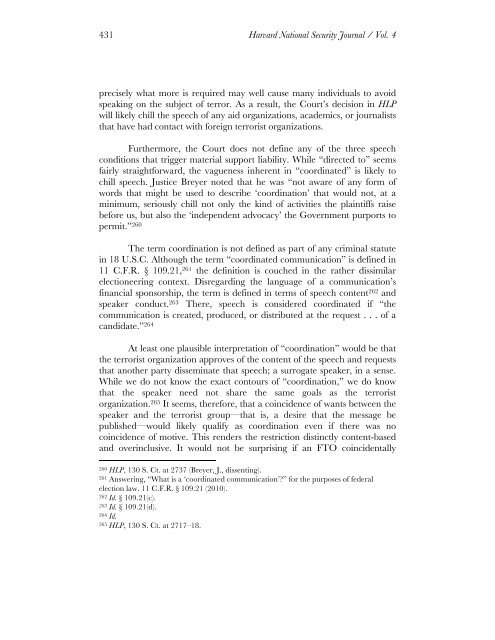Vo.4-Moshirnia-Final
Vo.4-Moshirnia-Final
Vo.4-Moshirnia-Final
Create successful ePaper yourself
Turn your PDF publications into a flip-book with our unique Google optimized e-Paper software.
431 Harvard National Security Journal / Vol. 4<br />
precisely what more is required may well cause many individuals to avoid<br />
speaking on the subject of terror. As a result, the Court’s decision in HLP<br />
will likely chill the speech of any aid organizations, academics, or journalists<br />
that have had contact with foreign terrorist organizations.<br />
Furthermore, the Court does not define any of the three speech<br />
conditions that trigger material support liability. While “directed to” seems<br />
fairly straightforward, the vagueness inherent in “coordinated” is likely to<br />
chill speech. Justice Breyer noted that he was “not aware of any form of<br />
words that might be used to describe ‘coordination’ that would not, at a<br />
minimum, seriously chill not only the kind of activities the plaintiffs raise<br />
before us, but also the ‘independent advocacy’ the Government purports to<br />
permit.” 260<br />
The term coordination is not defined as part of any criminal statute<br />
in 18 U.S.C. Although the term “coordinated communication” is defined in<br />
11 C.F.R. § 109.21, 261 the definition is couched in the rather dissimilar<br />
electioneering context. Disregarding the language of a communication’s<br />
financial sponsorship, the term is defined in terms of speech content 262 and<br />
speaker conduct. 263 There, speech is considered coordinated if “the<br />
communication is created, produced, or distributed at the request . . . of a<br />
candidate.” 264<br />
At least one plausible interpretation of “coordination” would be that<br />
the terrorist organization approves of the content of the speech and requests<br />
that another party disseminate that speech; a surrogate speaker, in a sense.<br />
While we do not know the exact contours of “coordination,” we do know<br />
that the speaker need not share the same goals as the terrorist<br />
organization. 265 It seems, therefore, that a coincidence of wants between the<br />
speaker and the terrorist group—that is, a desire that the message be<br />
published—would likely qualify as coordination even if there was no<br />
coincidence of motive. This renders the restriction distinctly content-based<br />
and overinclusive. It would not be surprising if an FTO coincidentally<br />
260 HLP, 130 S. Ct. at 2737 (Breyer, J., dissenting).<br />
261 Answering, “What is a ‘coordinated communication’?” for the purposes of federal<br />
election law. 11 C.F.R. § 109.21 (2010).<br />
262 Id. § 109.21(c).<br />
263 Id. § 109.21(d).<br />
264 Id.<br />
265 HLP, 130 S. Ct. at 2717–18.
















